

There are windswept days in the Arizona Desert where seemingly every color of the spectrum may be examined upon close inspection. This particular area is just north of McKellips Road and Crismon Road in East Mesa, an area where Usery Mountain Regional Park stands adjacent to Tonto National Forest. After a period of seasonal rain, it is amazing to see how green this area becomes, bursting with lime-green, yellow-green, emerald green and dozens of other varieties of spectacular hues. When the desert is dry, one notices the rust-colors, the tans, the yellow ochres, the bleached greys, faded green hues and ashen rocks. The wildlife also exhibits great variety of color, from flashy iridescent hummingbirds to motley colored songbirds and rustic desert quail. Once I visited a Park nearby and witnessed Harris hawks sailing high overhead, looking like noble black falcons on a cerulean blue sky. I am reminded of a phrase coined by American artist Wolf Kahn, a gifted painter and fantastic landscape artist. Kahn once told a group of Drew University art students that he was intrigued by "the tangles of nature," those outdoor spectacles we notice when we truly study and observe the natural environment which surrounds us. The Arizona Desert is indeed such an environment, filled with tangles and colorful spectacles stretching from the desert floor all the way to the blue-grey, purple and lavender mountain peaks.
0 Comments
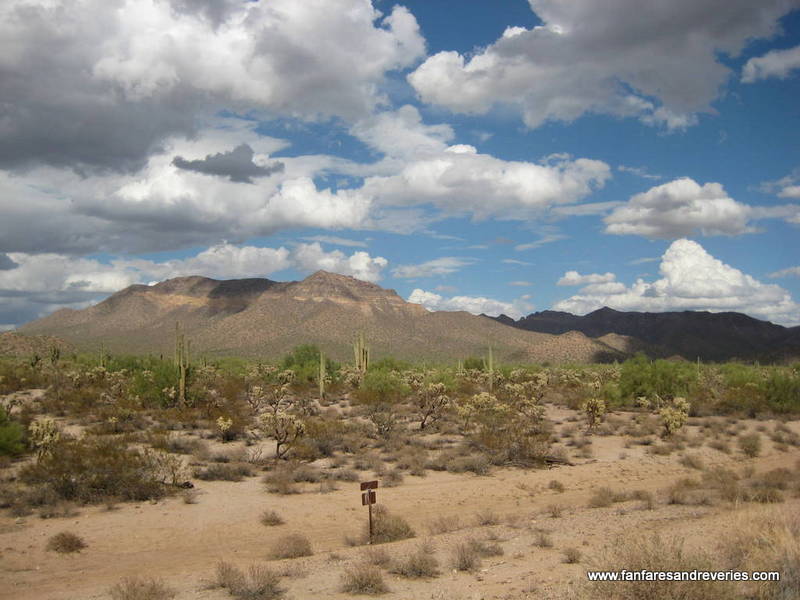 I love the contrasts between light & shadow upon the desert mountains of Arizona. This area is known as Usery Mountain Regional Park, located just 20 minutes from my home in Mesa. The Park encompasses 3,648 acres and is situated at the western end of the Goldfield Mountains, adjacent to the Tonto National Forest. Pass Mountain rises to 2,840 feet and features a spectacular hiking trail which allows views of 70 or more miles into the distance beyond. The lower Sonoran Desert is a fascinating place offering a wealth of rich color and a diverse variety of flora & fauna. On a bright day with palatial clouds sailing overhead, you can absorb the pulse and atmosphere of this remarkable environment. As you take in the sweet birdsong and distant calls of wildlife, for just a moment you begin to absorb the manifold beauties of the wilderness preserve. 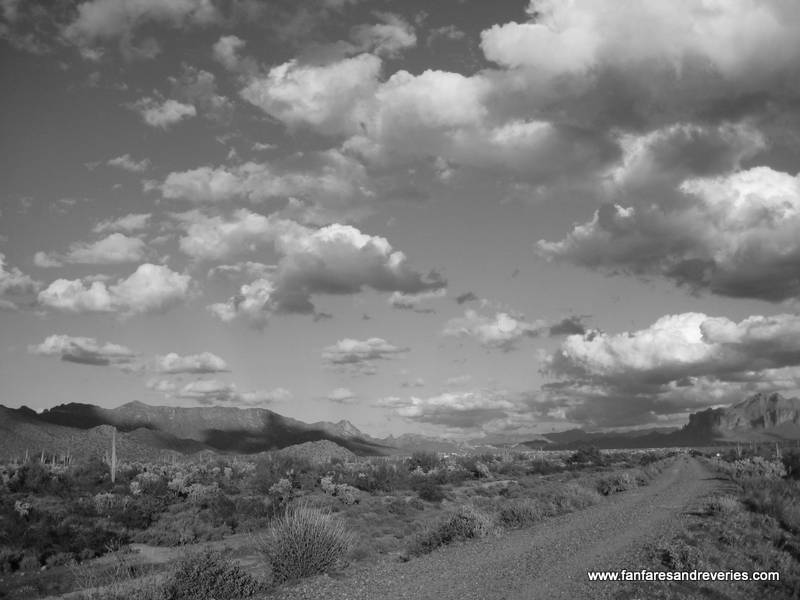
There is a special majesty in watching palatial clouds silently sail above the Desert landscape of Arizona. I vividly recall Alexander Korda's 1940 fantasy film masterpiece "The Thief of Bagdad." When I view scenes such as the one included here, I am transported to another world, a place of enchantment foretold in "The Arabian Nights" stories. Antoine Galland popularized these spectacular tales in "The Thousand and One Nights" (1704), forever immortalizing names such as Sinbad, Aladdin & Ali Baba. Korda's film stars John Justin as Prince Ahmad, Conrad Veidt as Jaffar, June Duprez as the Princess, and Sabu as Abu. On a day when these splendid clouds sail high overhead, I reflect upon the stunning visual imagery captured by those magnificent flying carpet scenes. Through the art of wondrous special effects, I too fly high above the earth via a heightened sense of ebullient imagination.
 Image size 3" diameter, pen & ink, G. Tompkins Image size 3" diameter, pen & ink, G. Tompkins A Wilderness Journey & a Memorable Encounter Many years ago I drove from my home in Mesa to spend a day hiking in the Superstition Mountains at Lost Dutchman State Park, just north of Apache Junction, Arizona. It is a leisurely drive from where I live to the entrance of the Park, perhaps 30 to 40 minutes, with clear views all around and a rare majesty of the mountain/ desert interface on panoramic display. On this particular day I brought an Audubon Bird Call with me as well as some reading material, good hiking boots, comfortable clothing (safari style), a couple of snacks, plenty of water, and a nice cowboy hat to offer some shade from the hot desert sun. Early in the morning I started up the main trail and hiked a brief segment until I found a shady spot next to some palo verde trees and rock outcroppings. There I found a perfectly secluded spot where no one could see me and I could rest amidst the bounty of natural flora & fauna, taking delight in these extraordinary surroundings. A Startling Sound & A Brilliant Display As I became entirely comfortable in this desert hideaway, I began to read and to quietly mimic the sound of bird chirps through the use of the bird call. After a few minutes I suddenly became aware of a thundering sound and a delicate palpitation right next to my right eye and upper cheek. I thought for a moment that it was a very large bumble bee or honeybee and I just froze unable to move. This winged phenomenon was beating its wings wildly in an extraordinary manner, and I could hear it and feel it so distinctly, perhaps only 6 inches from my face. I turned my gaze ever so slightly toward this object and noticed very bright, iridescent colors, and a very long, slender and narrow bill. It was a beautiful hummingbird just hovering next to me, apparently attracted by the sound of the bird call and looking me over from cowboy hat to dusty boots! This moment only lasted a brief minute or two, yet I was so delighted and stunned to come that close to such a beautiful creature. The little fellow took off after a suitable inspection, allowing me to savor that spectacular chance meeting as a divine and cherished gift. The Audubon Bird Call The Audubon Bird Call was invented in 1947 by Roger Eddy, an author and member of the Connecticut State Legislature. This small device, just a couple of inches in length, is made of cast zinc (or other metal) and birch wood, made in Rhode Island and available from many specialty shops in either red or natural wood color. You can twist the metal knob and mimic the sounds of a host of different species of birds, from chirping sounds to song-like tweets. The wooden chamber may be treated with a bit of rosin (usually supplied by the manufacturer) in order to keep it at its best sound-producing capability. If kept dry and away from moisture or humidity, the bird call should last indefinitely and provide many hours of bird-watching enjoyment. Hummingbirds Hummingbirds are fascinating creatures to watch, with estimates of anywhere between 60 to 200 times per second of the flapping of their delicate wings. They experience a fast breathing rate, fast heartbeat, and high body temperature, can fly up to 60 miles per hour, are capable of incredible gyrations & mid-air maneuvers, and can live 5 to 6 years in the wild. There are some 320 species extant, covering a wide swath of geographical territory, often migrating appreciable distances. Their colors are fabulous in richness and vibrant in texture, shining in a spectacular manner, especially in the deserts of Arizona, a location noted for brilliant sunshine year round. Lost Dutchman State Park 40 miles east of Phoenix stands this remarkable sanctuary, nestled within the Sonoran Desert, featuring many trails which lead into the Superstition Wilderness and the Tonto National Forest. You can hike Siphon Draw Trail to the top of the Flatiron, an elevation of 4,800 feet, a height which affords a monumental view of the Valley below. At that elevation, Phoenix looks like a city made of toy blocks perhaps one quarter inch high along the distant horizon, and Mesa and Apache Junction fan out in dazzling array as far as the eye can see. Mule deer, coyote, javelina, jackrabbit, desert quail, and cactus wren populate the landscape here, with hiking trails and nature trails adding to the convenience of 72 campsites within the perimeter of the Park. The name "Superstition Wilderness" was apparently inspired by Pima Indian legends, and one may still find evidence of cliff dwellings and caves in this area. Salado or Hohokam Indians may have populated this landscape 100's of years ago, with Pimas, Apaches and Yavapais living here subsequently. In the 1800's this area became an Apache stronghold. In the 1840's the Peralta family of northern Mexico produced a gold mine here. In the 1870's Jacob Waltz and his partner Jacob Weiser apparently located the mine, but kept its location a well-guarded secret. After Waltz died in 1891, no one was ever able to find the exact location of "The Dutchman's" lost mine.  Pen & ink w/watercolor, 12 x 14", Glenn Tompkins Pen & ink w/watercolor, 12 x 14", Glenn Tompkins Remembrance As a Path Toward Understanding After the young Martin falls off the spinning carousel, the effects of focused light and Bernard Herrmann's music add tremendous drama to the overall evocation of this scene in "Walking Distance." As the light fades away, one by one the children leave the darkened, now silently still carousel horses, revealing a brief gallery caught by the camera. A succession of wonderfully carved horses momentarily fills the screen, each one cast in motionless pose, as if suspended in frozen animation. Herrmann's accompanying music brilliantly underlines the emotional sadness of this powerfully reflective glimpse into the human heart. We sense Martin's coming-of-age as he grapples with these uniquely personal events, a time of intense introspection as well as a time of endearing compassion. As the music and dramatic lighting bring key elements to the foreground, Martin's father (played by Frank Overton) steps forward after meandering through the maze of carousel horses still visible in the distance. A Father Speaks to His Son The quality of Rod Serling's writing can be seen and heard in the next few moments of this luminous story. Martin's father finds his adult son sitting at the carousel's edge holding his hand to his head in anguish over the series of recent events. The dad sensitively approaches his son with the kindly spoken words, "I thought you'd like to know the boy will be alright." Here there are intimations of healing for both the physical and the hidden aspects of Martin's life. "I know who you are," the dad continues, revealing that Martin's license and identity have been confirmed through the wallet he accidentally dropped at his parent's home earlier that evening. "You've come a long way from here and a long time....How? Why? ....You know things that will happen. There's no room, no place. You have to leave here." Martin listens attentively to his father speak these heartfelt words, carefully measuring each phrase with an eagerness to fully understand his present predicament. "It was once your summer....It's his summer now," (referring to the young 11-year-old boy). "We only get one chance. Maybe there's only one summer to a customer." Instead of looking backwards, Martin's father suggests tenderly, "Try looking ahead." Martin agrees with his dad, beginning to sense the wisdom imparted to him through this intervention in time. As the carousel silently starts up, Martin hops aboard to gain another ride, this time with a smile, with renewed understanding, now on a transitional journey toward the closing scene. Final Scene of "Walking Distance" The last scene revisits the drug store/ emporium which first appeared at the beginning of this story. Martin discovers a lively perspective as he enters this crowded atmosphere in the store which features his favorite three-scoop chocolate ice cream soda. Now there is loud music, dancing teenagers, and a different soda jerk at the fountain. Initially desiring to order his favorite dessert, Martin strikes up a conversation with the fountain attendant, but then decides to forgo the treat. The attendant asks about Martin's slight but noticeable limp and difficulty in getting up from the counter. Martin says that he injured his leg when he was eleven years old and fell off a merry-go-round. The attendant says, "Merry-go-round? They tore it down....condemned it!" Rod Serling's closing narration speaks eloquently and endearingly about the almost universal desire to go home again, "...that a man might not have to become old, never outgrow the parks and the merry-go-rounds of his youth." 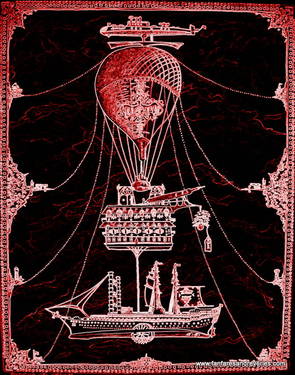 Pen & ink w/watercolor, 10"x 14", Glenn Tompkins Pen & ink w/watercolor, 10"x 14", Glenn Tompkins Between Afternoon & Night in "Walking Distance" As Rod Serling begins his voice-over during the transition phase between afternoon and night at Homewood, we sense the rapidly changing pace of events for Martin Sloan in this seemingly idyllic neighborhood. Previously in the day Martin had attempted to meet his parents only to have them shut the door in his face, due to their incredulous reaction to his far-fetched claims. Now as the evening progresses, Martin finds himself again drawn to the home which he considers his own, a place which he fondly remembers from his childhood years. Under the mysterious mantle of descending darkness, Martin crosses the street and walks across the lawn of the house he once knew as a young boy. He rings the bell on a bicycle but another hand stops him abruptly, revealing the presence of Martin's father. "Back again?" Martin only wants to convince everyone that he is not lying and has proof of his true identity. As the porch light comes on, Martin's mother appears at the front door of the house, inquiring about the noise and unusual conversation on the front lawn. Martin leaps up the front steps and tries to convince his mother that he has factual personal history, a driver's license and further documentation to provide complete proof of his identity. But in an emotional scene etched with fear, fright and confusion, Martin's mother cuts off the conversation as a sign of rejection, no longer having the patience to listen to his irrational claims. To the Park Amidst the Lights & Music of a Carousel After facing his parent's rejection, Martin runs to the local Park where a carousel is brightly lit and revolving. In an incredible moment, he sees himself riding the carousel, at age eleven just as he remembers from his treasured past. Through an overhead camera angle, situated precariously high upon the carousel superstructure looking downward at the horses and children, we see the adult Martin furiously chasing the eleven-year-old Martin, as the horses prance rhythmically in motion and the carousel spins unrelentingly forward. Suddenly the young Martin falls off the carousel as we hear, "Oh my leg, my leg!" The adult Martin, out of reach of his eleven-year-old counterpart, clutches his own leg as he grabs forward in pain. There is the realization of the adult causing the injury to the child. At this moment the music of Bernard Herrmann is almost overwhelming in its power and emotional impact. Martin walks slowly toward the boy just as a sense of strong light enters the picture and the children one-by-one dis-mount their fanciful steeds. "I only wanted to tell you...Martin, I only wanted to tell you that this is a wonderful time of life for you. Don't let any of it go by without enjoying it." The carousel operator holds the injured boy in his arms and carries him away. At this moment the light fades in the distance and the children all begin to leave. As the light still focuses upon Martin (in a unique spotlight fashion), there is tremendous sadness expressed in the accompanying music. "That's all I wanted to tell you," Martin repeats as violins recite some evocative phrases in falling lines, with still shots in half-light of the various carousel horses all silently bearing witness to the tragic nature of events which have just transpired. This is one of the most beautifully expressed, carefully composed and hauntingly photographed scenes in all of the five seasons of "The Twilight Zone," a tribute to the very high production values of this series overall. 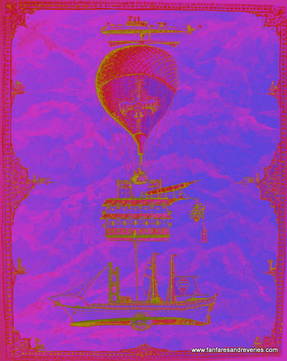 Pen & ink with watercolor, 9" x 13", G. Tompkins. Pen & ink with watercolor, 9" x 13", G. Tompkins. Passages of Time - The Carousel & Bandstand Rod Serling's "Walking Distance" exhibits some bittersweet moments for a man in search of his past. When Martin Sloan's parents do not recognize him, there is a sense of loss and sadness at the doorstep of the home he once knew. In the next adjacent scene, we briefly meet a young man who is admiring a brand new car, freshly minted out of Detroit. As Martin takes in the shiny visage before his very eyes, the young man states that the car is a 1934 Roadster, leaving the distinct impression that this event is taking place through an incredible regression in time. Now Martin begins to understand this inexplicable excursion beyond the rational elements he initially expected via his revisit to Homewood. Atmosphere & Drama in a Series of Events The next scene is one of the most atmospheric moments ever presented on "The Twilight Zone." Having left the young man with the 1934 Roadster behind, we now realize that nightfall has descended upon the neighborhood, with church bells gently ringing in the distance. Lampposts along the street radiate their distinctive glow as interior lights fill the windows of Homewood's stately houses. At this moment I am reminded of the memorable artwork of Belgian surrealist Rene Magritte (1898-1967), an artist who often captured that otherworldly atmosphere just between sundown and early evening. One such masterpiece is entitled "The Empire of Light" painted between 1950 and 1954, a lovely composition delineating some of the enchantment and charm of this unique time of day, with the light of the sky acting as counterbalance to the positively mysterious glow emanating from streetlamps and interior houselights along the boulevard. One cannot perfectly distinguish whether Magritte has painted either a day scene or a night scene, yet the evocation of transient light remains fascinating and almost hypnotic in overall effect. Unique Perspectives Rod Serling's voice-over enters this atmospheric night scene, a moment of literary and philosophical insight adding dramatic pause toward further contemplation. "A man can think a lot of thoughts and walk a lot of pavement between afternoon and night." Here we begin to grasp this integration of varied elements, in retrospect realizing both the short and long passages of distance and time, from the country gas station to the Homewood sign to the people who live in this rather special place. Serling continues as narrator, "Memory suddenly becomes reality....Martin Sloan is back in time....his resolve is to put in a claim." Full realization of all these unusual elements will take place as Martin comes face to face with a powerfully emotional event from his childhood. A chance, a time of life and a revisit will help to clarify the hazy textures of Martin's treasured youth. 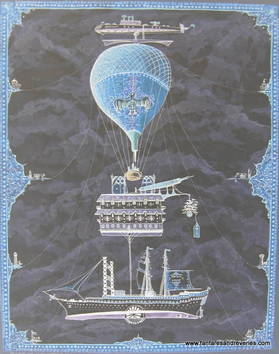 Pen & ink with watercolor, 8" x 11", G. Tompkins Pen & ink with watercolor, 8" x 11", G. Tompkins The Music of Bernard Herrmann (1911-1975) One of the special aspects to "Walking Distance" is the magnificent contribution made by composer Bernard Herrmann via his evocative musical score which accompanies Rod Serling's heartfelt, wistfully remembered story. Few thirty-minute television programs ever beheld such fabulous musical composition as the gifted passages heard throughout this neatly crafted episode of The Twilight Zone. Herrmann has long held a rather distinguished place among soundtrack composers in both film and television. In 1974 and 1975 Decca/ London Records released two blockbuster recordings on the London Phase 4 Stereo label which showcased some of Herrmann's best scores for film. "The Fantasy Film World of Bernard Herrmann" features the composer conducting the National Philharmonic Orchestra in scores from "Journey to the Center of the Earth," "The Seventh Voyage of Sinbad," "The Day the Earth Stood Still," and "Fahrenheit 451." Some interesting liner notes are provided by the composer describing his designs for each individualistic score. The second disc is entitled "The Mysterious Film World of Bernard Herrmann," again featuring the composer conducting the National Philharmonic Orchestra at Kingsway Hall, London, all offered in London's superlative Phase 4 Stereo sound. This album highlights some selections from "Mysterious Island," "Jason and the Argonauts," and "The Three Worlds of Gulliver." These two albums became sonic favorites for many audiophiles, testing the full range of the audio spectrum via high-powered amplifiers, large speakers/ monitors and fine-quality turntable, cartridge & arm combinations. A Glimpse Into the Interior of "Walking Distance" After Martin Sloan finishes his conversation with the soda fountain attendant at the drug store, the scene switches to a wistful glance upon the beautiful boulevards and sidewalks of Homewood, as a walk down the street enlivens the cherished memories of a youth spent amid idyllic surroundings. The lovely trees, lush landscaping, neatly manicured lawns and stately homes instill within Martin a longing for the past as he takes in the brilliant sunlight and notices the bicycles and barking dogs of this enchanting neighborhood. A chance meeting with a young boy playing on the street allows Martin to reminisce about his early memories, but this scene ends abruptly when the little boy says, "You're not Marty Sloan...," and then runs away oblivious of the official driver's license which Martin attempts to offer as proof of his identity. Martin then walks to the park and notices an ice cream vendor whereupon he says to a local resident "Nothing quite as good as Summer, being a kid." In a wild twist of historical imagination, Martin then sees a young man carving his initials on the wooden post of a bandstand, remembering that he did the same thing at age eleven many years ago. When Martin approaches the young man, he sees that it is really him at age 11, the same way he looked at that age. The young man runs away fearful of being caught. At this point Martin decides to re-visit his old house, the place where he grew up and where his parents once lived. He rings the bell, but his parents don't recognize him. As Martin looks through the screen door at the front of the house, one notices a grey haze, a separation between the present and the past, an unbridgeable gap of understanding between the adult Martin and the young Martin we have just met moments ago. Martin Sloan finds that he is not known in this version of Homewood, far afield from the idyllic childhood which he still cherishes and remembers from his youth. 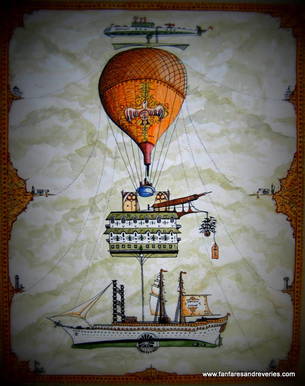 Watercolor, pen & ink, 8" x 11", artist: G. Tompkins Watercolor, pen & ink, 8" x 11", artist: G. Tompkins "Walking Distance" - October 30, 1959 One of the most memorable episodes presented on The Twilight Zone was written by Rod Serling and first seen on television in October of 1959. "Walking Distance" features Buck Houghton as producer, Robert Stevens as director and George T. Clemens as director of photography. This finely written story stars Gig Young in the lead role along with a superbly chosen supporting cast, beautiful sets from MGM, and a superlative musical soundtrack composed by Bernard Herrmann. Themes of Remembrance, Travel & Time Rod Serling grew up in Binghamton, New York and fondly remembered his childhood experiences at Recreation Park, especially the magnificent carousel and ornate bandstand. There are moments of wistful remembrance enshrined in this remarkable episode, reflections upon travel & transportation, realizations of how distance and time may change our perspectives, and a yearning to rediscover the innocence & vitality of youth. Cars, Territory & Memories In the first scene of "Walking Distance" we see a sports car rapidly driving directly toward the camera, just about to bypass a country gas station in a relatively rural area. The driver comes to an abrupt halt off-camera and then quickly backs up to the vicinity of the gas pumps at the station. There is a bit of dust flying in the air as Martin Sloan (Gig Young) impatiently honks the horn for service, trying to gain the attention of the busy attendant in the background. We can sense this businessman's competitive spirit, his tight schedule of preordained appointments and his somewhat edgy demeanor in dealing with the tasks at hand. Rod Serling's voice-over speaks about Martin Sloan "looking for sanity up the road," seeking an "exodus" but finding something a bit different from what might be expected. The attendant says it will take about an hour to do an oil change and lube job, to which Martin responds "I'm not in a hurry." As Martin gazes toward a sign which says "Homewood - 1.5 miles" across the street on the side of the road, he rather wistfully states "Grew up there. Haven't been back in 20/ 25 years." 1.5 miles is walking distance from the location of the gas station, a trip which he decides to undertake while his car is being serviced. The Vortex of the Past The next scene features the soda fountain/ drug store which we associate with small-town America in the 1930's/ 1940's. While an overhead fan circulates in steady fashion, Martin enters this fascinating place, glancing at the fully stocked shelves, taking notice that he is the only customer in this magnificent emporium. A soda jerk emerges from behind the fountain just as Martin reminisces that the town still looks "exactly the same," a picture postcard of historic preservation. "It's funny, how many memories you connect with a place," says Martin as he enjoys an ice cream soda. He thought that everything would be changed, but it's as if he just left yesterday, "Just as if I'd been away overnight." |
Author
|

 RSS Feed
RSS Feed